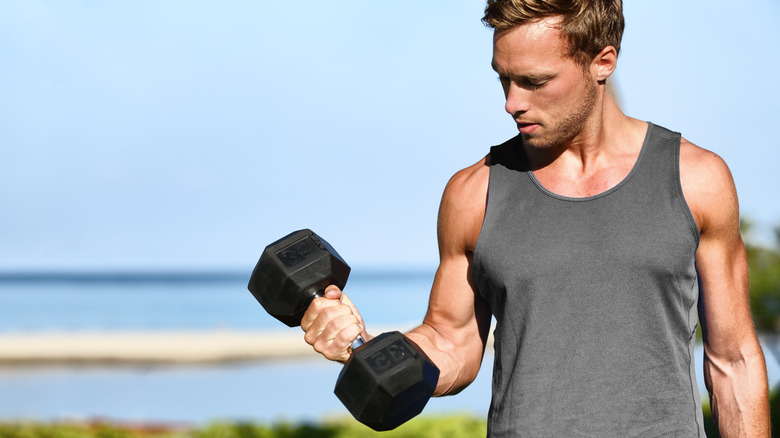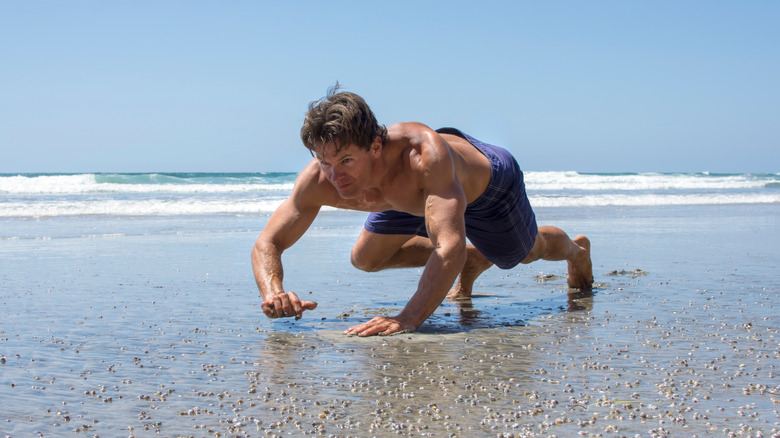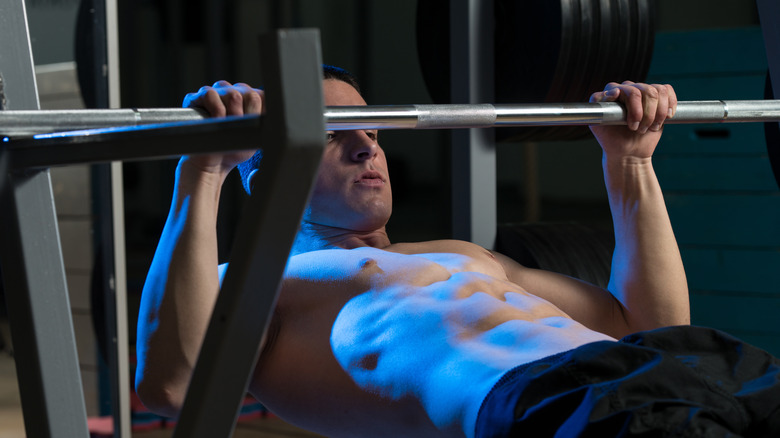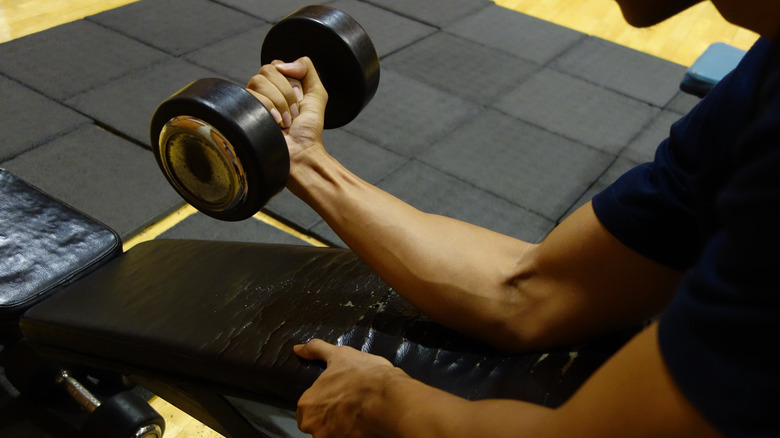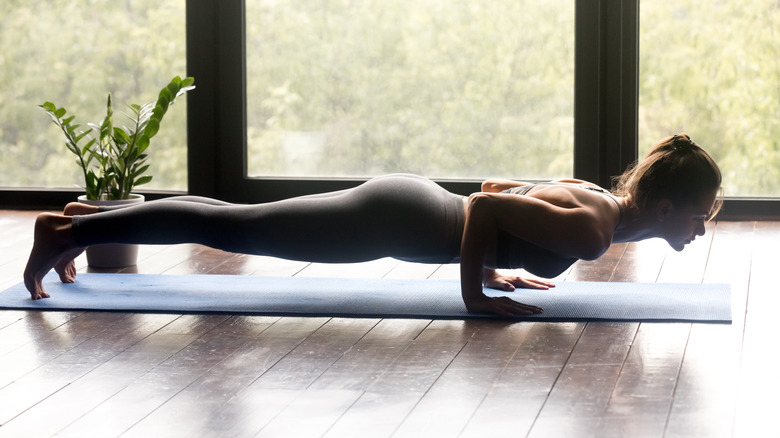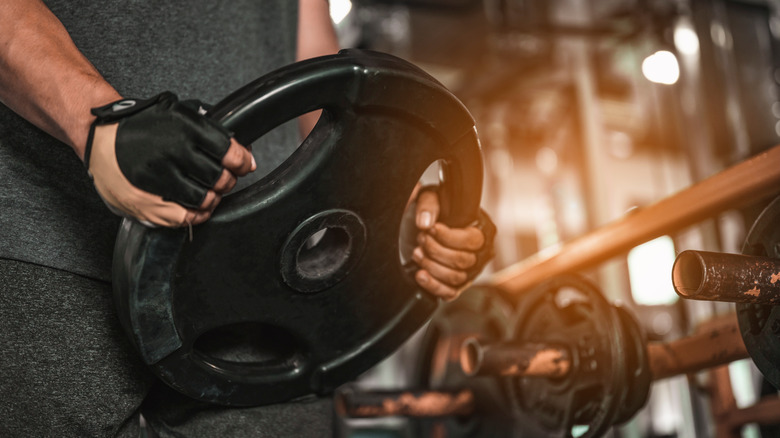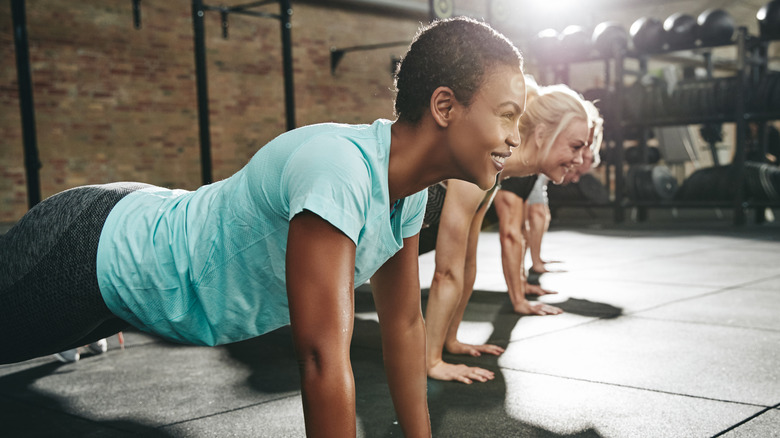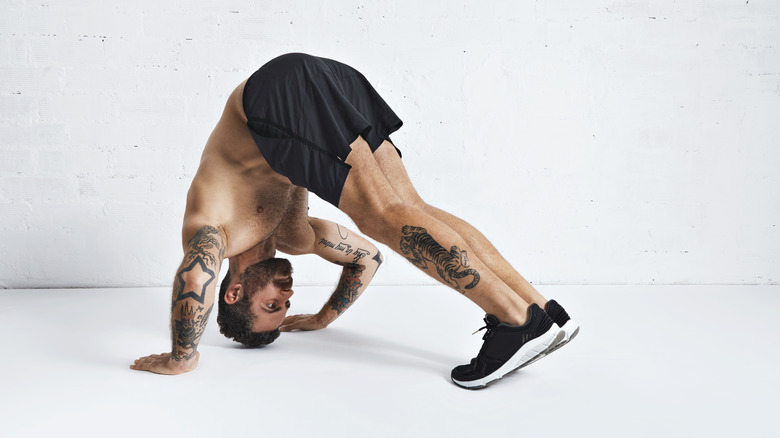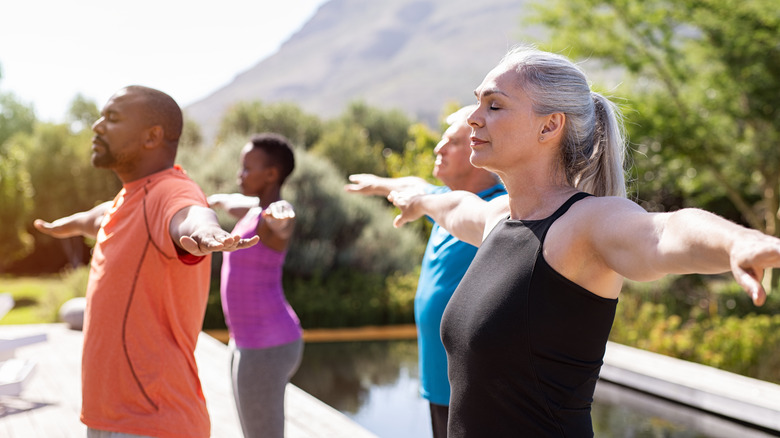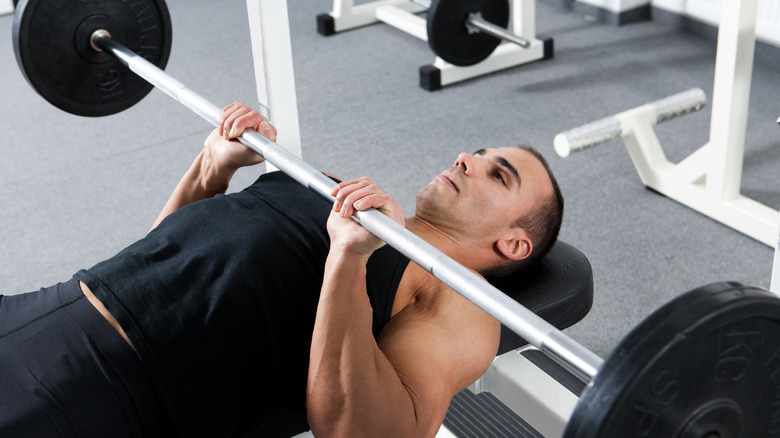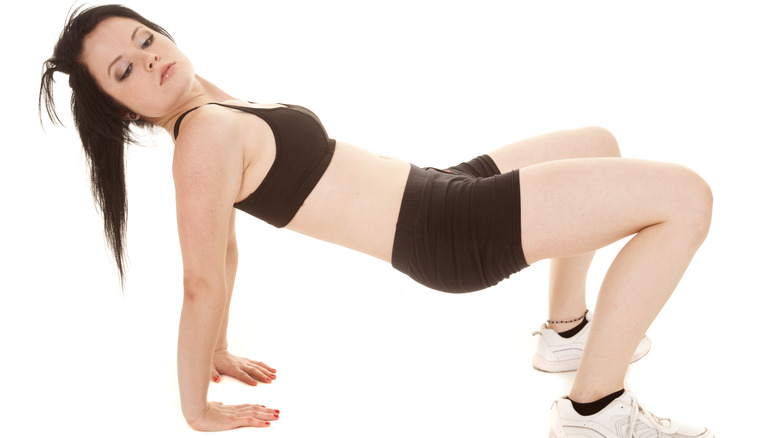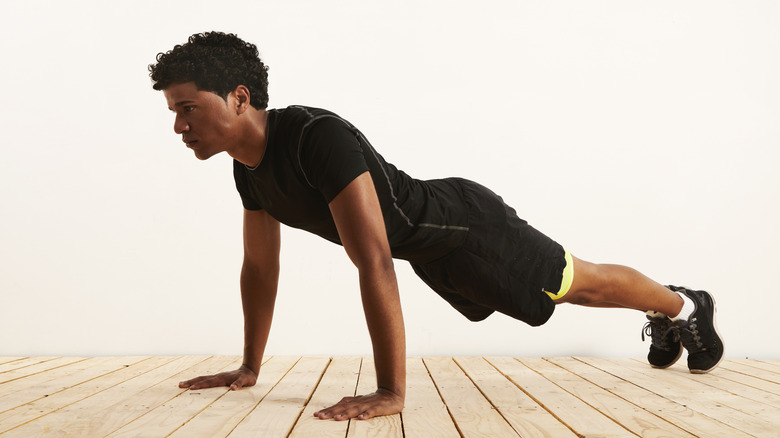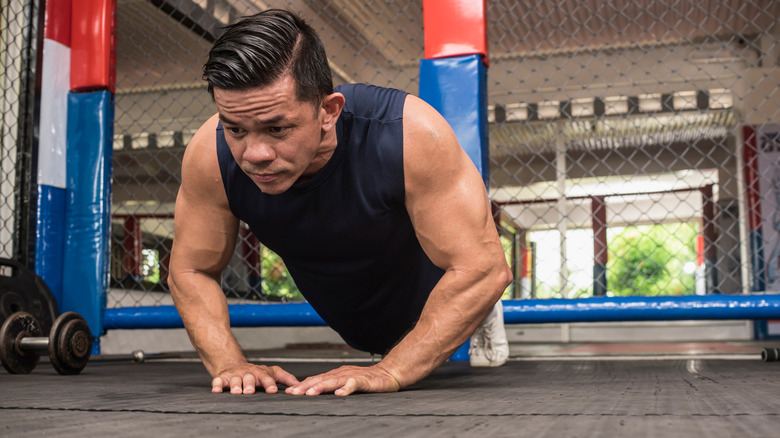The Best Arm Exercises You Probably Aren't Doing
The benefits of exercising your arms go beyond simple cosmetic value. "A strong upper body is essential for anything from good posture and daily activities like putting the groceries away, to injury prevention and more," certified strength and conditioning specialist Allen Conrad, owner of Montgomery County Chiropractic Center in North Wales, Pennsylvania, told Livestrong. And arms are certainly part of this equation.
But, if we're being honest, arm exercises can quite frankly be, well, pretty samey. It's all too easy to just fall back on exercises like standard bicep curls and pushups to build our arms (and upper-body) strength, when in fact, changing up your arm exercises can bear real fruit. As Jackie Wilson, founder and CEO of NOVA Fitness told Livestrong, "There's a misconception that push ups are the exercise to do to build upper-body strength, but that's not the case. Mixing in other exercises ... is a better way to build a strong upper body than just doing pushups because it keeps your body guessing and presents it with different challenges to adapt to."
We've put together some of our favorite lesser-known arm exercises to help you shake things up and reinvigorate your fitness routine.
Zottman curl
Having a well-developed set of biceps can be great, but it's not exactly the most exciting journey to get there sometimes. So next time you hit the gym, sub out your regular bicep curls with the little-known (and excellently named) Zottman curl. Named after the famed 19th-century strongman George Zottman, who invented the exercise, the Zottman curl exercises both your biceps and your forearms, the development of which is essential for strong grip (via Coach).
To perform the exercise, take a pair of dumbbells and grip them in a supinated position, also known as an underhand grip, and curl them as you would a regular bicep curl, according to Bodybuilding. When your hands reach the top, pause and rotate your wrists into a pronated (or overhand) position, and then lower the weight. The rotation and grip on the way down will cause further activation to your forearms. Then, repeat the exercise until the end of your set of reps. Don't try to go for the highest weight possible with a Zottman curl — prioritize performing the move correctly with quality reps, instead of showing how much you can lift.
Bicep curl in a stationary bear crawl
Putting your body in an entirely new position while you work your biceps can not only mix up your workout but help to engage other muscles too. Such is the case with a bicep curl in a stationary bear crawl, which takes advantage of the position of the bear crawl to also activate your core, leg, shoulder, and back muscles, making this a fantastic compound exercise.
Begin by moving onto your hands and knees, with your knees placed under your hips and your wrists under your shoulders (per Daily Burn). Engage your core and, keeping your back flat, slowly lift your knees off the ground by an inch or two. Hold this position, and then lift your right hand, turn your palm towards your chest, and curl your hand towards it in a bicep-curl movement until your right arm is perpendicular to your left one. Uncurl your arm, place your right hand back on the floor, and repeat the movement on the left side. Continue to alternate until the end of your set, and then repeat as necessary.
Inverted row
In addition to activating your biceps and your forearms and improving strength in both of them, as well as grip strength, inverted rows also give your back muscles an incredible workout, according to Healthline, meaning that this is a bodyweight exercise you shouldn't pass up. This movement is ideally done in a gym using a bar attached to a power rack, but you can also do it at home using a table or a bar laid across two chairs; just be very careful doing so and, as Nerd Fitness points out, make sure everything is super stable to avoid the risk of injury.
To perform it in a gym, set a bar in the rack to around waist height (setting it higher will make the exercise easier, and lower will make it harder). Lie face up under the bar, and grab it with an overhand grip slightly wider than shoulder-length. Contact your core and glutes and, keeping your body straight, pull yourself up so your chest touches the bar. Then, lower yourself back down, keeping the form correct. If you want a little more emphasis on your biceps, you can switch to an underhand grip, as Men's Health suggests.
Isometric towel curl
One thing that can sometimes stop people from working their biceps effectively is the sheer cost of weights and the presumption that you need them to really tone up your arms. Well, the isometric towel curl is a great exercise that lets you get a great bicep workout in using just your bodyweight and a towel for resistance.
Simply take a full-length towel (ideally one you're not going to use when guests come to stay) and with your arm parallel to the floor and your elbow close by your side, step on the towel using the foot on the same side that you're holding it (per Fit & Me). Then, pull the towel up as hard as you can, contracting your bicep while you do so. Maintaining the full contraction and force, hold for 10 seconds, keeping your elbow by your side, and then release. The towel's resistance is what works your bicep and the muscles in your forearm. Repeat the exercise on the other side, or the same side as many times as required.
Wrist dumbbell curls
The forearms are often engaged during other arm exercises, but finding ways to focus on them solely is important for your exercise regime. The benefits that forearm training has for grip strength can't be understated, as New Jersey certified personal trainer and chiropractor-in-training Nick Occhipinti told Greatist, "Almost every exercise we do involves holding onto a weight in some way. A stronger grip means more stability to the wrists and elbows as well as more force production in exercises that require a strong grip."
Wrist dumbbell curls are a great exercise to feel the burn in your forearms. Take a pair of dumbbells of moderate weight, and sit down on a chair or an exercise bench, with your forearms resting on your thighs or on the bench in front of you. With your wrists facing either up or down, lower the weights using only your hands as far as you can (make sure to keep a strong grip on the dumbbells here). Then, curl them up, again as far as you can go, and return to the starting position. Repeat for 12 reps and three sets or until your muscles tell you that's enough!
Chaturanga
Yoga can do wonders for the mind — and the body. Although yoga's considered a more gentle form of exercise, doing yoga regularly is an effective way to build your muscle mass. "Think of it this way: holding certain yoga poses is still tearing muscle fibers, [while] using body weight as tension. The body's response is to build more muscle, as a backup," yoga instructor and Aaptiv trainer Ceasar F. Barajas told Aaptiv. The chaturanga pose is one that you'll really feel in your arms.
Performing chaturanga in isolation will work multiple muscles in your arm, but will particularly target your forearms as well as your core strength and stability, according to Muscle & Fitness. Start in a full plank, and with your elbows kept by your side, lower your upper body so that your elbows, shoulders, upper arms, and chest are all in line. Hold the pose, and then push back up to plank, or upward dog. Muscle & Fitness suggests performing this exercise for two sets of 10 reps, with a short break of 30 seconds in between; alternatively, do it for as long as you feel your muscles can take.
Pinch-hold for forearms
We generally train our muscles using dynamic movements, but incorporating isometric exercises into our strength-building repertoire can give our muscles, particularly those which are harder to train, some real love. Holding our muscles in static, contracted positions allows their strength and endurance to build, and for the forearm muscles, which are harder to engage with movement, they can be a real game-changer.
That's why we recommend giving the plate pinch-hold a go (via Muscle & Fitness). In a standing position, take a weight plate (start with a weight that you're comfortable with if you're new to the exercise, and work up from there), and grab it between your thumb and fingers. Extend your arm towards the floor and hold the weight tightly for 30 seconds. Switch your plate to the other hand and repeat — or you can do the exercise with a plate of equal size and weight in each hand. If you're having trouble gripping your weights, try switching to hollowed-out plates, as flatter plates can prove tricky to keep hold of.
Push-back pushup
Let's be real, regular pushups can get boring. Finding variations can not only help keep things interesting but can engage your muscles differently, keeping them constantly challenged. A push-back pushup is great for this. "This is one of my favorite push-up variations for all skill levels. First, it's a great exercise to build pushing strength. Next, it challenges core control as you transition from the push-back to push-up position. Finally, it is great for overhead shoulder stability and mobility," Darren Tomasso, performance coach at The Session NYC, told Greatist.
Start in a full plank, with your feet slightly wider than shoulder-width. Move your body towards the floor as you would in a normal pushup, but instead of pushing back up into the original position, push your upper body back towards your heels, with your legs bending and your hips moving towards your feet. Make sure your back stays flat and your spine long, and then push your upper body forward with your lower body, to return to the full plank. It's a great move for your shoulders and triceps, as well as your chest and abs.
Pike pushup
A pike pushup is a variation on a regular pushup that'll hit your shoulders and triceps hard. Place your feet on a chair or box, and place your hands in front of you on the floor in a downward dog position (you can also do this exercise with your feet on the floor, without elevating them). Make sure your hands are wider than your shoulders and your fingers are facing forward, and then, bending your elbows, slowly lower your head to the floor. Your arms should make a 'goal post' position, and your elbows shouldn't be going further than your wrists. Push back up to straighten your arms, without locking your elbows.
This can be a tricky move to nail, so personal trainer Krista Stryker, founder of 12 Minute Athlete, has some tips. "Keep your elbows close to your sides as you do these. This will make the exercise much more difficult but will lead to much better form and increased strength in the long run," she told Greatist. "Also, make sure you're keeping your core tight throughout the entire movement. You should feel like you're pulling your ribs up and inward."
Arm circles
Arm circles are a simple exercise that can be done to your comfort level. What's more, they engage the shoulders, the bicep, and the triceps effectively, making this one an efficient way to activate multiple arm muscles at once. To perform the exercise, stand with your feet at shoulder-width, with your arms extended out to the sides of your body at shoulder level, according to Shape. Without letting your shoulders bunch up towards your ears, move your arms in a small circle backward 20 times.
Then, switch directions, and repeat the exercise with a forward motion. You can repeat this exercise as much as necessary, or treat it as a workout and move on to more intense exercises. When you're performing the forward-circle motion, try not to let your chest collapse inward, Internal Force Fitness advised. Doing so will reduce the engagement of your arm and shoulder muscles, and how effective the exercise ultimately is.
Close-grip bench press
Simple changes to how we perform exercises can alter the engagement of our muscles, and altering your grip to perform a close grip bench press can get your arms involved even more. "Placing your hands closer together makes it so your triceps have to work harder. That can lead to new growth and more strength," advises Craig Ballantyne, owner of Turbulence Training (via Men's Health).
To begin, lie down on an exercise bench with your feet flat on the floor as with a regular bench press, and grip the barbell. But, instead of taking a wider grip as in a standard bench press, grasp the barbell at shoulder-width. Then, lower the barbell down to your chest, pause, and push the weight back up to your original position, making sure not to lock your elbows at the top. It's important not to move your grip too close, as this could cause instability and injury to the wrist, according to Coach. Try to avoid arching your back as you perform the exercise, and keep your elbows close to your sides during the movement, to get the maximum engagement in your triceps.
Crab walk
The crab walk is a pretty efficient (and, dare we say, fun) compound exercise which engages your hips, glutes, and your forearm muscles — but the star of the show here are the triceps, which take on the brunt of the work. Begin sitting normally on the floor, with your legs extended out in front of you at hip-width (per Muscle & Fitness). Place your hands on the floor slightly behind your back, with your fingers facing towards your hips.
Then, planting your feet on the floor, lift your hips and body, and slowly "walk" forward, using alternating hands and feet to do so (it's useful to have a fair amount of space in front of you when doing this exercise). Move forward for around 10 paces, and then repeat the motion back to return to your starting position. Do this for around 60 seconds, and then rest for a minute before repeating the set. Don't rush the movement in the beginning, as it may take a little time to get used to the motion.
Bodyweight tricep extension
A regular pushup will target your triceps pretty effectively, but you can take it to the next level by isolating the muscles using a bodyweight tricep extension. Begin in a standard pushup position or full plank. Move your hands forward on the ground so that they're around 10 inches further up than they'd usually be for a pushup — your fingertips should be a little bit further ahead than your forehead, as Fit & Me advises. Make sure your fingers are facing forward.
Then, keeping the alignment in your whole body and your core and glutes engaged, slowly lower down until your forearms are resting fully on the floor. Then push your body back up to your original position, making sure your elbows are close to your sides and your triceps are engaged throughout. This can be a little bit of a tricky maneuver if you've never done it before or are building up the strength for it, so if the full extension is too challenging, you can modify it by placing your knees on the ground as you do so.
Diamond pushup
Working your triceps will not only add mass to your arm but can help when it comes to performing all manner of compound exercises. "The triceps involvement in compound exercises can help overall strength and force output, which can help someone generally get stronger or more skilled and more technically efficient in all those types of movements," Toronto-based certified personal trainer Lee Boyce told Self. A diamond pushup is a great way to focus on your triceps through a compound exercise, while also engaging the other muscles (the shoulders, the chest) that a pushup normally does.
Begin in a standard full plank as you would with a regular pushup: wrists under your shoulders, your glutes and core engaged, and alignment throughout your full body. Then, walk your hands into each other so that your index fingers and thumbs create a triangle on the floor. Lower your upper body so that your chest comes towards your hands, and then push back to the starting position. According to Boyce, the close position of your hands engages your triceps more, as they have to do additional work to push your body back into position.


